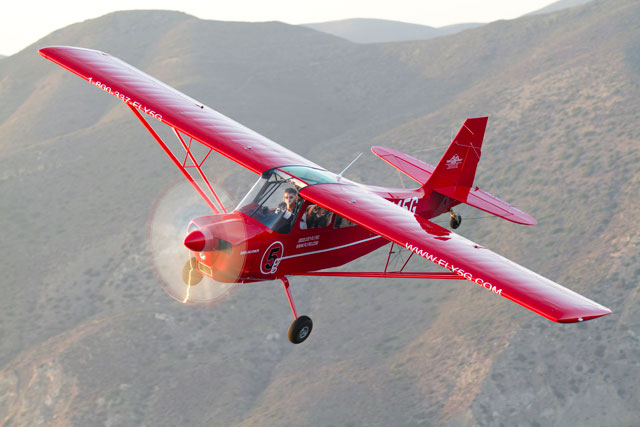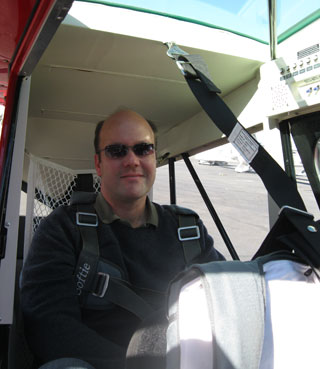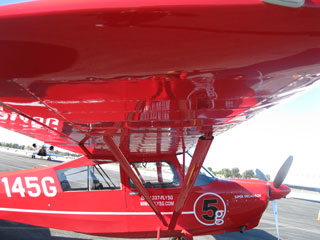Don't let the ground loop get you
Tailwheel training provides challenges, boosts stick-and-rudder skills

5G Aviation CEO Ty Frisby flying the Super Decathlon. Photo by Jessica Ambats, courtesy of 5G Aviation.
The sense of being powerless in an aircraft is terrifying. We’re trained to control the airplane and correct dangerous situations that arise. But in this developed, low-speed ground loop demonstration, I’m powerless. Applying full right rudder during the uncontrolled left turn yields no results. Brakes are no help. All I can do is hang on while the forces push me toward the side of my seat and wait for the Super Decathlon to come to a stop on its own.
If the Decathlon were going any faster, “the wing would tip and hit the ground, and you’d end up with an expensive repair bill,” said Ron Rapp, a Gulsftream IV pilot and tailwheel flight instructor with 6,300 hours total time. He teaches ground loop demonstrations so that pilots transitioning to tailwheel aircraft can see how the turn tightens leading to a ground loop, how the rudders become ineffective, and how much damage an aircraft could sustain. Depending on the type of taildragger and speed, ground loops can cause a wing or prop to strike, damage the landing gear, or worse.
Point taken. That demo starts the transition training for this nosewheel pilot with a healthy dose of respect for safely taxiing, taking off, and landing a tailwheel airplane, along with a hint of fear for failing to do so.
Learning to land the sporty Super Decathlon at Southern California’s John Wayne Orange County Airport on a 2,800-foot paved runway may not seem like a traditional way to earn the endorsement (a J-3 Cub at a short grass strip with trees on both ends is more like it), but wake turbulence from the airliners landing on the parallel runway effectively cut the usable length to 1,400 feet; jet blast from Boeing 737s waiting to taxi onto their active runway created an obstacle. As my skill level increased, Rapp, a mentor CFI at 5G Aviation which provided the training, instructed me to land on one side of the runway, cutting its width from 75 feet to 37 feet. (I must admit, I used most of the 75 feet on the first couple of takeoffs and landings.)
Taming the tailwheel
On the ground, tailwheel aircraft are naturally unstable because the center of gravity is located aft of the main landing gear. Ever tried to push a tricycle backward? With the slightest turn, the tricycle wants to veer to one side or the other, or spin. That’s how a tailwheel behaves moving forward.
“The important thing with the tailwheel is that you have to keep the nose straight, so the airplane has to be pointed in the same direction that it’s going,” Rapp explained. That’s easier said than done. “Anytime a divergence starts to develop between those two things, you’re going to see that ground looping tendency.” The key to correct drifting off center on the runway or taxiway without ground looping is to stop the drift before bringing the aircraft back to the desired position. Holding the rudder too long or swerving could set you up for a ground loop.
 5G Aviation mentor CFI Ron Rapp.
5G Aviation mentor CFI Ron Rapp.
To introduce his students to the ground handling characteristics of the Super Decathlon, Rapp begins with taxi drills. There’s plenty of time—and room—to taxi at this Class C airport near Los Angeles International. Taxiway Alpha is wide enough for Boeing and Airbus jets and offers the perfect place for the zigzag drill: cross the taxiway at a 45-degree angle, turn to parallel the centerline, then take a 45-degree cut back across the taxiway, turning to parallel the centerline on the other side. The zigzag maneuver is more difficult than the S-turn, according to Rapp, because the crisp turns and stops require more rudder control.
Figure eights—taxiing large loops connected by diagonal lines—teach the coordination of power, rudder, and brake. They also demonstrate how the tailwheel aircraft wants to tighten a turn as it progresses. A turn to the left, for example, will require periodic right rudder inputs. To make the drill more difficult, Rapp suggests trying it on a windy day, applying all of the correct aileron and elevator inputs as you change direction.
Two critical considerations while taxiing are keeping the stick back so that the tailwheel has better steering authority, and positioning the controls for the wind. Muscle memory dies hard, so remembering to keep the stick back while exiting the runway or taxiing can be difficult for tricycle gear pilots who typically release back pressure on the control wheel once aerodynamic braking is no longer necessary. I had a tendency to release the stick each time after coming to a stop and turning to clear the runway.
The common saying, “Climb into, dive away from” for control positions during taxiing in windy conditions holds true for tailwheel aircraft, but pilots should be careful not to automatically assume they should release the stick’s backpressure just because of a tailwind. Consider whether the tailwind is stronger than the propwash flowing over the tail surface before applying your control inputs. The Super Decathlon’s large rudder surface and light weight make it want to weathervane into the wind. With a left quartering tailwind at John Wayne, I had to apply right rudder just to taxi straight.
Three-point and wheel landings
After what seemed like the 100th time going around because of a bounced landing in the Super Decathlon (realistically, it was probably the twentieth), I began to form my own opinion as to why the federal aviation regulations require currency landings in tailwheel aircraft be to a full stop, whether day or night: The challenge in landing a taildragger is bringing the aircraft to a stop without ground looping.
“Remember, the key is just round out low, just as you would with a nosewheel airplane. Actually the technique is almost the same,” Rapp counseled. “You’re going to hold the airplane off the ground until you reach the three-point attitude, and when it settles, you get real active with your feet.
“At the moment the plane touches down, the stick should still be coming back.” 
For three-point landings, Rapp suggests pilots try to make the tail touch first, which actually sets them up for the three-point pitch attitude. When the mains touch first on a three-point attempt, the aircraft will bounce. “If the tailwheel is not on the ground, easing back on the elevator control may cause the airplane to become airborne again because the change in attitude will increase the angle of attack and produce enough lift for the airplane to fly,” the Airplane Flying Handbook explains.
With wheel landings, however, the goal is for the mains to touch first.
“Wheel landings are all about finesse,” Rapp said. And patience. Forcing the mains onto the runway and pushing the control stick forward to transfer the weight onto the wheels can result in a bounce or pilot-induced oscillations. Pilots must wait for the mains to touch before advancing the stick forward—and then, be patient while the aircraft decelerates before bringing the tail down (I lifted off after bringing the tail down too soon).
“It’s normal to sort of fear pushing the stick too far forward,” Rapp said. Performing roll-ups—landing in the three-point attitude and then lifting the tail—will help a pilot get the feel for how far forward the stick must go during wheel landings.
Most of my 50 hours of tailwheel time up to the point of the transition training had been spent in cruise flight or doing aerobatics, with only few landings under my belt, but I quickly learned the feel required to finesse three-point landings; wheel landings took more practice. After seven hours and 44 landings, including practice in 18-knot crosswinds, I earned the endorsement and a higher level of skill for landing that I can apply to flying tricycle-gear aircraft. I also gained a soft spot for the Super Decathlon. Since none are available for rent at my home base in Frederick, Md., I’m pursuing a checkout in its close relative, a Citabria, that’s for rent at a nearby airport. Here’s to many more ground-loop-free takeoffs and landings.



